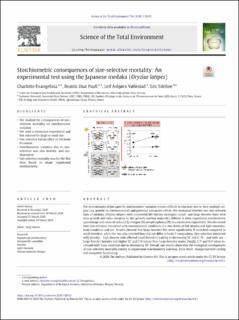| dc.contributor.author | Evangelista, Charlotte | |
| dc.contributor.author | Diaz Pauli, Beatriz | |
| dc.contributor.author | Vøllestad, Leif Asbjørn | |
| dc.contributor.author | Edeline, Eric | |
| dc.date.accessioned | 2021-05-03T11:10:29Z | |
| dc.date.available | 2021-05-03T11:10:29Z | |
| dc.date.created | 2020-03-31T14:49:06Z | |
| dc.date.issued | 2020-07-01 | |
| dc.Published | Science of the Total Environment. 2020, 724 (138193), . | |
| dc.identifier.issn | 0048-9697 | |
| dc.identifier.uri | https://hdl.handle.net/11250/2753226 | |
| dc.description.abstract | The determinants of intraspecific stoichiometric variation remain difficult to elucidate due to their multiple ori- gins (e.g. genetic vs. environmental) and potential interactive effects. We evaluated whether two size-selected lines of medaka (Oryzias latipes) with contrasted life-history strategies (small- and large-breeder lines with slow growth and early maturity vs. fast growth and late maturity) differed in their organismal stoichiometry (percentage and ratios of carbon [C], nitrogen [N] and phosphorus [P]) in a mesocosm experiment. We also tested how size-selection interacted with environmental conditions (i.e. two levels of fish density and light intensity), body condition and sex. Results showed that large-breeder fish were significantly N-enriched compared to small-breeders, while the two size-selected lines did not differ in body P composition. Size-selection interacted with density – high density only affected small-breeders leading to decreasing %C and C: N – and with sex – large-breeder females had higher %C and C:N values than large-breeder males. Finally, C:P and N:P ratios in- creased with body condition due to decreasing %P. Overall, our results show that the ecological consequences of size-selective mortality extend to organismal stoichiometry and may, from there, change nutrient cycling and ecosystem functioning. | en_US |
| dc.language.iso | eng | en_US |
| dc.publisher | Elsevier | en_US |
| dc.rights | Navngivelse 4.0 Internasjonal | * |
| dc.rights.uri | http://creativecommons.org/licenses/by/4.0/deed.no | * |
| dc.subject | Evolusjon | en_US |
| dc.subject | Evolution | en_US |
| dc.title | Stoichiometric consequences of size-selective mortality: An experimental test using the Japanese medaka (Oryzias latipes) | en_US |
| dc.type | Journal article | en_US |
| dc.type | Peer reviewed | en_US |
| dc.description.version | publishedVersion | en_US |
| dc.rights.holder | Copyright 2020 The Authors | en_US |
| dc.source.articlenumber | 724 | en_US |
| cristin.ispublished | true | |
| cristin.fulltext | original | |
| cristin.qualitycode | 2 | |
| dc.identifier.doi | https://doi.org/10.1016/j.scitotenv.2020.138193 | |
| dc.identifier.cristin | 1804597 | |
| dc.source.journal | Science of the Total Environment | en_US |
| dc.source.40 | 724 | |
| dc.source.14 | 138193 | |
| dc.source.pagenumber | 1-8 | en_US |
| dc.relation.project | Norges forskningsråd: 251307, 255601, 272354, 268218 | en_US |
| dc.subject.nsi | VDP::Økologi: 488 | en_US |
| dc.subject.nsi | VDP::Ecology: 488 | en_US |
| dc.identifier.citation | Science of The Total Environment. 2020, 724, 138193 | en_US |
| dc.source.volume | 724 | en_US |

